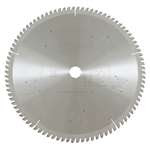The body, often called the plate, is the platform in which everything else is positioned. The plate must be absolutely flat to run true. The plate must be processed in a manner that treats and tensions to a point of extreme durability. This will enable the blade to continue to run true even when exposed to rigorous cutting, like when it is fully embedded in the material. The process of grinding and sharpening the tooth contributes to the quality and performance of the blade. Lower quality saw blades are made from ground and sharpened steel. They are adequate, but it is well worth upgrading to high quality carbide-tipped blades, which are mostly made of steel- but have cutting teeth of tungsten carbide, a strong, hard, heat-resistant ceramic.
The carbide tooth plays a very important role in the performance and life of the blade. Carbide comes in many different compositions and grades. These carbide tips are brazed onto the blade’s steel body. They are more durable and hold an edge longer; the tips are wider than the body, which makes the blade less likely to bind in the cut.
 Shapes of Teeth Configurations
Shapes of Teeth Configurations
Flat Top (FT) – This configuration is used for ripping, because of its deep gullets and aggressive hook angle. Not suited for crosscutting. The tops of the teeth are ground straight across like a rip saw.
Alternate Top Bevel (ATB) - This style produces smooth crosscuts and aggressive ripping.
Teeth alternate right and left for faster, cleaner cuts. Every other tooth is ground at an angle toward the center of the blade, like a crosscut saw.
Alternative Top Bevel & Raker – similar to the plain ATB, this style is found on most combinations blades serving as an all purpose, cross cut/ rip blade. The Rakers purpose is to follow-up after the other teeth and clean-up or “rake”, thus the name – Raker.
Triple Chip (TC) – Similar to the FT, but every other tooth has its top corners beveled off and the heights of the teeth alternate. Designed not to dull quickly, these blades are suited for materials such as laminates, acrylic, or non-ferrous metals.
Blades for More Specialized Applications
Thin Kerf Rip Blade – Known for its steep hook angle, deep gullets, and few, flat top ground teeth. These blades are thinner than standard ones. This makes less work for the saw and less wood lost to the cut.
Combination Blade – There are expansion slots cut into the rim, which help reduce noise and vibration.
Abrasive Blade – Used in hop saws and miter saws to cut ferrous and non-ferrous metals. These blades are available in different tasks, and are made from resin-bonded aluminum oxide or silicon carbide.
Diamond Blades – used to cut masonry, tile, stone, and concrete. Diamond grit is soldered or laser-welded to the rim of the blade. The rim may be segmented or continuous. Some blades must be flushed with water during use to clean the kerf, cool blade, and allow for deeper cuts. Others can be used dry, but take care to avoid overheating.
Dado- Used in a table saw to cut a long, continuous groove in a piece of wood, known as a dado. The set consists of a pair of outer blades and a group of splitters, which are sandwiched between blades. CMT got excellent
press on the CMT #230.012.08 Dado Pro Set
Frame More Houses. Faster.
Irwin has introduced a new player in the world of saw blades with the introduction of the Marathon with WeldTec. This new saw blade has Welded carbide teeth and they claim 30% stronger tooth bond that promises you longer life. UC2 (submicro grain) carbide teeth are 70% tougher than standard carbide teeth and are sharpened to finer, more durable cutting edges that stay sharper longer. Irwin uses E.O.T. grind technology.
Braze vs. Weld
Standard brazed blades use a breezing material, which acts like a glue, to join the carbide tooth to the steel plate. This bond is only as strong as the brazing material, which softens as heat builds up during a cut and can cause tooth loss upon impact.
Marathon with WeldTec has welded carbide teeth. Welding fuses the carbide teeth to the steel plate, which makes the bond as strong as the base material. This bond is unaffected by heat build up and results in better tooth retention.
Makita has also introduced a high quality, thin kerf, carbide-tipped blade for fast, efficient cutting in various materials. The MakBlade is 7 ¼” with 16 teeth, Makita claims that their technology produces a blade that is faster, stronger, and quieter.












No comments:
Post a Comment